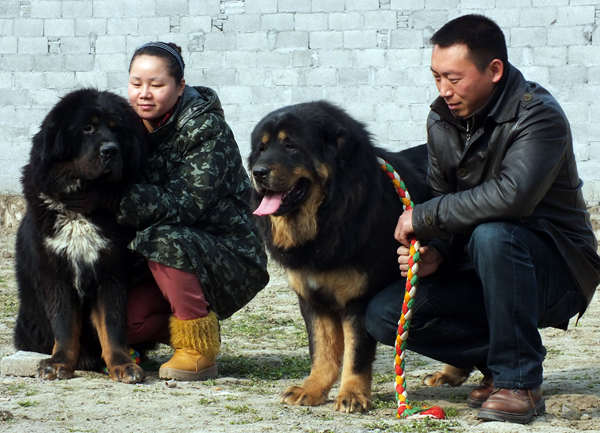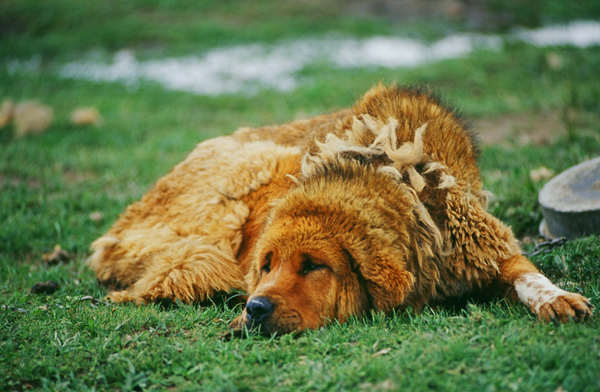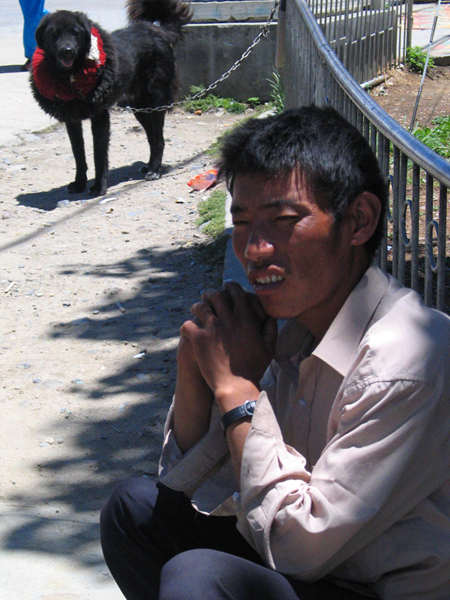Abandoned Tibetan mastiffs pose threat to snow leopards' primacy

Similar to luxury cars, villas and overseas assets, a Tibetan mastiff was once seen a status symbol for China's nouveau riche. [Photo by Liu Junfeng/China Daily]
Even though the snow leopard in the Sanjiangyuan region, an area of the Tibetan Plateau in Qinghai province, is at the top of food chain, it is now being challenged by the Tibetan mastiff.
Ironically, the dogs are abandoned homegrown mastiffs, and the snow leopards usually give up their prey after being confronted by the dogs.
Such scenes were rare in the past, but with the number of abandoned mastiffs surging between 2012 and 2014, and snow leopard numbers declining as a result human activities, poaching and climate change, these kinds of encounters are now fairly common.
Lion-like mastiffs, native to the Tibet autonomous region and neighboring Qinghai province, were traditionally trained as sheep dogs and watchdogs by herders.

Lion-like mastiffs were traditionally trained as sheep dogs by herders. [Photo by Xu Zhuoheng/China Daily]
But the main reason for their abandonment was the excessive breeding of Tibetan mastiffs between 2003 and 2013 when a pedigree mastiff could be sold for between 50,000 yuan ($7,272) and 1.5 million yuan in China's coal-rich Shanxi and Shaanxi provinces, as well as in the Jiangsu, Shandong and Henan provinces.
Similar to luxury cars, villas and overseas assets, a Tibetan mastiff was once seen a status symbol for China's nouveau riche. And the market for Tibetan mastiffs reached its height in 2012, when a dog was reportedly sold for 20 million yuan in Qingdao, Shandong province.
But China's growing wealth has not only found its way solely into the mastiff market.
In recent years people also started to raise giant spiders, lacertilians, chinchillas, ponies and even snakes in urban areas.
However, as China's economy slowed down, the newly rich reduced consumption and demand for the dogs began to fall.
But due to the previously skyrocketing prices for Tibetan mastiffs in previous years, many herdsmen started to raise Tibetan mastiffs in an intensive management model in both Qinghai and Tibet.
As they were not professional breeders or dog lovers, many of them did not know enough about such dogs, including how to tell a real one from the mixed-blood one.
Then, as the result of falling demand and poor quality dogs, there was a glut of mastiffs, which led to large-scale abandonment.
 |
[Photo by Nan Shan/ China Daily] |
Now, many areas are taking measures, including establishing shelters and sterilization, to manage and control the population of these giant Tibetan dogs.
Meanwhile, animal welfare activists in Beijing are reported to have saved 21 Tibetan mastiffs and 150 other dogs from being taken to a slaughterhouse where the animals would have been sold for $5 a head.
Separately, the dogs have also had an adverse impact on the natural environment.
For instance, dongchongxiacao, or Chinese caterpillar fungus - used in traditional medicine - which grows on the Tibetan Plateau, has been destroyed by the dogs.
Also, the Tibetan mastiffs are not only eating wild animals, but also eating cattle raised by local farmers.
The Tibetan mastiffs are believed to have evolved from the gray wolf in that area over 42,000 years ago.
They are more closely related to gray wolf as compared with other dogs, according to a study by the Shanghai branch of Chinese Academy of Sciences released in 2016.
Your Comment
Name E-mailRelated News
-
;
Based in Lhasa, Tibet Vista is a Tibet travel agency that specialized in Tibet permit, and Tibet tours for both private and group travelers at a local price!
•4 Days Lhasa City Group Tour from USD 460 •8 Days Everest Base Camp Group Tour from USD 850 •15 Days Mt.Kailash Group Tour from USD 1780 •2016 Tibet Train Tours from Beijing, Shanghai, Chengdu, Xining,etc










